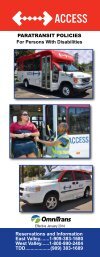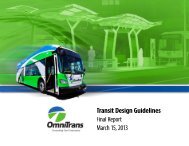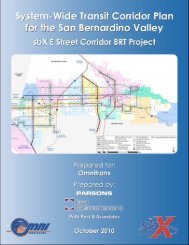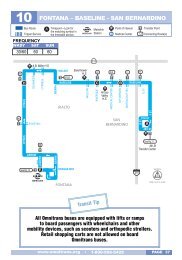Short Range Transit Plan 2008-2013 - Omnitrans
Short Range Transit Plan 2008-2013 - Omnitrans
Short Range Transit Plan 2008-2013 - Omnitrans
Create successful ePaper yourself
Turn your PDF publications into a flip-book with our unique Google optimized e-Paper software.
IBI GROUP<br />
FOREWORD<br />
SHORT RANGE TRANSIT PLAN REPORT<br />
OMNITRANS COMPREHENSIVE OPERATIONAL ASSESSMENT<br />
& SHORT RANGE TRANSIT PLAN<br />
The provision of <strong>Omnitrans</strong> transit services in Southwestern San Bernardino County is at a critical juncture. On<br />
the one hand, transit continues to provide an essential social service, providing youths, seniors, and low-income<br />
workers who have limited or no access to an automobile with the means to access employment, educational,<br />
medical and social destinations. With road congestion continuing to increase in the County, and with it concerns<br />
about air quality and global warming, transit will be asked to shoulder a growing share of trip making.<br />
At the same time, the provision of high-quality, cost-effective transit services in the <strong>Omnitrans</strong> service area has<br />
never been more challenging. In the simplest of terms, ridership has been decreasing over the past several<br />
years, while costs have been increasing. There are many factors contributing to this situation, only some of which<br />
are in the direct control of <strong>Omnitrans</strong>. On the ridership side, while population and employment in the service area<br />
have continued to grow at a robust pace, they have continued to do so largely at the margins of the urbanized<br />
area, in single-family subdivisions and suburban business parks that are difficult to serve effectively if at all.<br />
Despite this, <strong>Omnitrans</strong> has been able to grow ridership in the quickly-developing West Valley, but that growth<br />
has been offset by job losses in the older East Valley communities, with the recent loss of key anchors such as<br />
the Carousel Mall and other retailers and office uses in downtown San Bernardino. Additionally, increasing<br />
congestion has significantly lowered the reliability of <strong>Omnitrans</strong> services in certain corridors at certain times of<br />
day, particularly in the East Valley where the system relies of a high number of route-to-route transfers. Finally,<br />
while <strong>Omnitrans</strong> is achieving its systemwide “pullout” goal (which measures missed trips due to personnel or<br />
mechanical reasons), any missed trip further erodes reliability and therefore ridership.<br />
The combination of decreasing ridership and increasing costs has led to a situation where <strong>Omnitrans</strong> is under<br />
threat of not meeting its State-mandated farebox recovery target of 20%, a situation that would exacerbate the<br />
current situation by endangering a key source of operating funds. Addressing the factors that have jeopardized<br />
achieving the mandated farebox recovery target will be a multi-year effort.<br />
This <strong>Short</strong> <strong>Range</strong> <strong>Transit</strong> <strong>Plan</strong> represents the first necessary step towards putting <strong>Omnitrans</strong> back on the road of<br />
increasing ridership and controlling costs. Reflecting the current financial situation, the plan presents a realistic,<br />
fiscally conservative scenario. First and foremost, it presents a series of service reductions and restructurings,<br />
and fare increases, aimed at not merely meeting the 20% farebox recovery ratio, but providing <strong>Omnitrans</strong> with a<br />
safety cushion to buffer against future cost spikes or ridership decreases, incrementally working towards a<br />
recovery ratio of 25% in the six-year timeframe of the <strong>Plan</strong>. The need to provide such a buffer effectively means<br />
that, using the conservative assumptions of the <strong>Plan</strong>, <strong>Omnitrans</strong> cannot be assumed to grow ridership until 2012,<br />
when the sbX Bus Rapid <strong>Transit</strong> system begins service.<br />
However, the <strong>Plan</strong> does provide some of the tools necessary to put <strong>Omnitrans</strong> once more on a healthy path of<br />
ridership growth. For example, while the recommended service reductions and restructuring will result in a shortterm<br />
drop in ridership, they will also free resources (buses and drivers), some of which can be redeployed to<br />
improve reliability in the corridors and times of day when this is an issue. If these strategies are successful,<br />
ridership will see an improvement. Also, in <strong>2008</strong> <strong>Omnitrans</strong> will undertake an update of its Strategic <strong>Plan</strong> which<br />
will look at all aspects of how <strong>Omnitrans</strong> conducts its business, with a view to revamping the organization to better<br />
utilize funding and resources. While this <strong>Short</strong> <strong>Range</strong> <strong>Transit</strong> <strong>Plan</strong> must be conservative and therefore cannot<br />
account for the potential cost savings from the Strategic <strong>Plan</strong>, it is likely that <strong>Omnitrans</strong> will be able to realize such<br />
savings, meaning that more resources can be put into new or expanded services. To this end, in the two<br />
Unconstrained Scenarios that are also a part of this <strong>Short</strong> <strong>Range</strong> <strong>Transit</strong> <strong>Plan</strong>, a menu of new services is<br />
provided. These include options such as reinstating the reduced services, further improvements in <strong>Omnitrans</strong>’<br />
core system (aimed at providing more consistent headways and spans of service), pilot projects to serve<br />
emerging <strong>Transit</strong>-Oriented Development areas, the extension of service to new high-density areas, and the<br />
provision of “precursor” limited-stop services along the sbX and other future Bus Rapid <strong>Transit</strong> corridors.<br />
This <strong>Short</strong> <strong>Range</strong> <strong>Transit</strong> <strong>Plan</strong> therefore fulfills two key objectives – a short-term plan to put <strong>Omnitrans</strong> once again<br />
on a solid financial footing, and the long-range service concepts that provide a blueprint for growing ridership<br />
once the immediate challenges are overcome.<br />
July 11, 2007<br />
i














